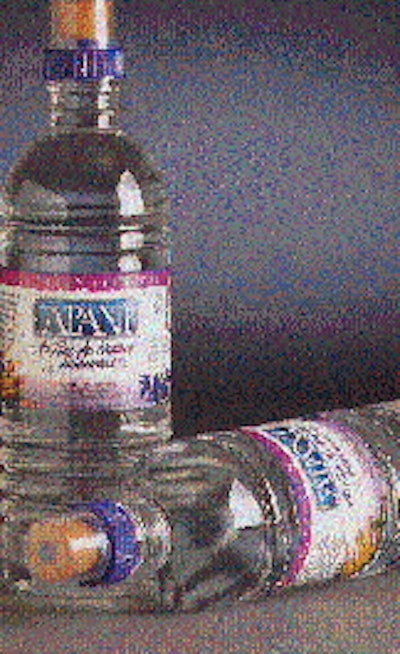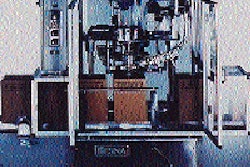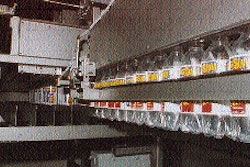Custom blowmolder Premier Plastics' San Jose, CA, plant entered the polyethylene terephthalate bottle market for the first time in mid-'94, following the purchase of a single-stage injection/stretch blow-molding machine. This year, the company expects to produce about 13 million half-liter bottles on the machine, for bottled water customers. "It was a significant step forward for us in that it allows our San Jose plant to produce a product using PET for the first time," notes general manager Jim Campbell. Premier Plastics is one of four core businesses under the umbrella of Tacoma, WA-based Premier Industries. Premier Plastics operates two plants, one in Tacoma, another in San Jose. "Together, we account for about 20 percent of the company's volume," Campbell estimates. From its 100ꯠ-sq-ft San Jose plant, Premier operates 14 machines that mold a variety of containers via both injection and extrusion blow-molding methods. Besides PET, the molder uses polyvinyl chloride, polypropylene, high- and low-density polyethylene and modified acrylonitrile resins. Upon customer request, the container manufacturer can also label containers (see p. 41), though it isn't yet doing that for its bottled water customers. Paving Premier's path into PET bottle manufacture is a Nissei ASB (Atlanta, GA) 650 biaxial orientation stretch blow-molding machine. Actually, the Nissei was purchased "for another project in the PET bottle business," says Campbell. "But that didn't come to fruition and we had a heavy investment in a machine that was really driving us. "Fortunately, we saw the growth of the bottled water market as a great direction for us to head for customers. There's high demand for the product, particularly for our customers who ship water to the Far East. That market is going to show a major increase in demand in the next few years." Premier Plastics serves customers in California, Washington, Arizona and Idaho. At this moment, the molder manufactures only a 500-mL size for water bottles. However, that's expected to change. "We'll be making a 1-liter bottle after we install a Nissei Model 300 machine later this summer," says Campbell. "Unlike the 650, which has 10 cavities, the 300 has 24. The additional cavitation will permit us to run the smaller bottles on the 300, and the new 1-liter size on the 650. Instead of taking two days to produce a truckload of bottles, we'll be able to do it in less than a day. We expect to make 40 million bottles a year at that point." By no means is the acquisition of the 300 meant to slight the 650 machine. On the contrary, the 650 "is a flexible machine," says Campbell. "It's a great machine for us, and at some point in the future, the next logical step for us would be to add a 1 1/2-liter size to complete a 'family' of PET bottles. When we're ready for that we would likely need another 650." Four-step process Bottles are produced from Eastman Chemical's (Kingsport, TN) Eastapak® 9921W PET resin. A vacuum hose draws resin from a corrugated gaylord up to the Nissei's hopper. Resin is sent to the hopper on demand, in batch form, as opposed to continuous flow. The hopper holds close to 1ꯠ lb of resin. Resin remains in the 320°F temperature hopper for approximately four hours for drying. Resin then descends into an injection screw that heats it to approximately 280°C. The injection screw delivers the molten PET to the injection cavities of the 650, where preforms are made. A turret transfers the PET through the machine's four production steps: injection molding; preform conditioning; stretch blow molding; and, ejection. Preforms and bottles remain in the neck-up position throughout the four-step process. Pet preforms The process begins with the upper and lower halves of the injection molds closing on the hot runner. Molten PET is then injected by the screw into the preform cavities, forming 10 preforms. The mold halves then open, and the turret rotates the preforms 90° to the second, conditioning step. This conditioning is completed with 10 conditioning "pots" that surround each of the preforms. A heating core is used to maintain the heat profile on the preforms, at temperatures between 350 and 400°F. Temperatures are controlled individually on each of the pots. Next, the turret rotates another 90° to the third step, stretch blow molding. Completing the cycle A solid stretch rod, about half the diameter of the inside neck dimension, descends into the open preform, pushing down at the base of the preform. Simultaneously, air is blown at 360 psi for 1 1/2 seconds around the rod, forcing the sides of the preform against the closed mold halves. By pushing down the base and blowing sidewalls out, the machine biaxially stretches the preform into the shape of the bottle. The bottle includes a series of sidewall ridges, for support and esthetic purposes. The molds open, and the turret rotates the set of 10 bottles to the fourth step where mechanical stripping devices eject bottles. Cycle times average 16 seconds. The 25.5-g bottles discharge to the bottom of the machine and ride an inclined conveyor to a manual packing station where operators place bottles in layers on a pallet. Usually, six layers, all separated by corrugated pads, form a pallet, which is stretch wrapped and shipped to the water company for filling, capping and labeling. Healthy returns Phoenix-based copacker Health For Life Brands of Arizona was the first of Premier Plastics' bottled water customers, using 500 mL bottles for its Health For Life and Apani "As pure as nature intended" brands, sold primarily to foodservice customers. "We consider the packaging of our product to be of the utmost importance," says Brian Beyer, general manager. "How people perceive our product is a major part of our business. We sell only purified water and the clarity of PET and the look of our label and cap are part of the concept. We spend a lot of money on packaging." The company, in business for about three years, became a Premier Plastics customer this year. "We were very impressed with the bottle appearance, quality and their customer service," Beyer says. "We plan to do more business with them, especially when they get into larger bottle sizes. Right now we sell 1- and 1.5-liter bottles, manufactured by other molders. It's really important to maintain a good relationship with all our suppliers," he continues, "because as we get into the hottest part of the summer and we begin searching for bottles, a good relationship means they'll be in better position to take care of our supply needs." To date, Premier Plastics' Campbell says, "our bottled water customers have been happy with our water bottle. There's a demand for the bottle, and even though we're new to this particular market, the future looks promising."























